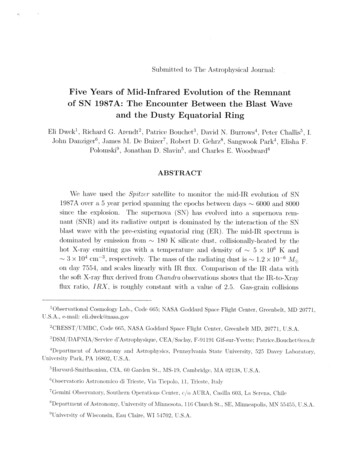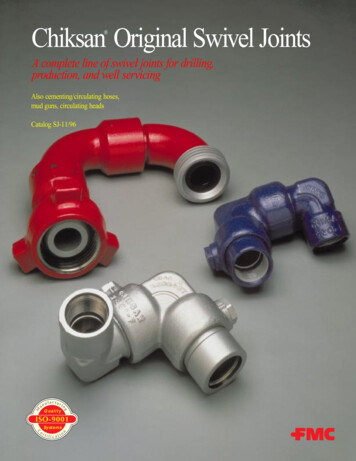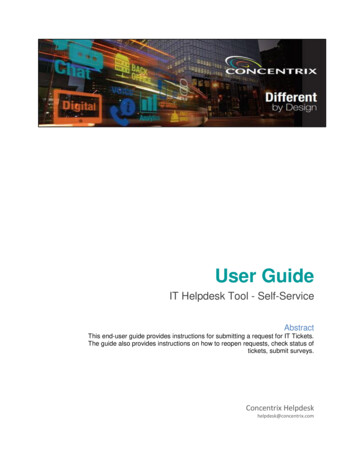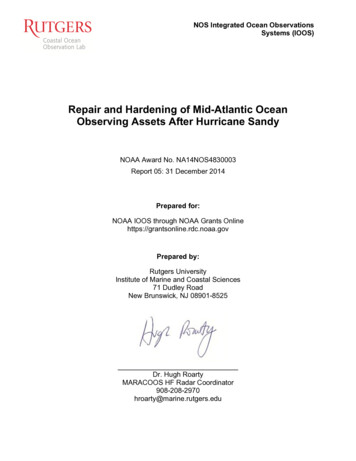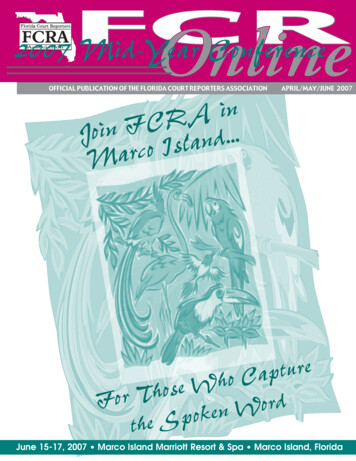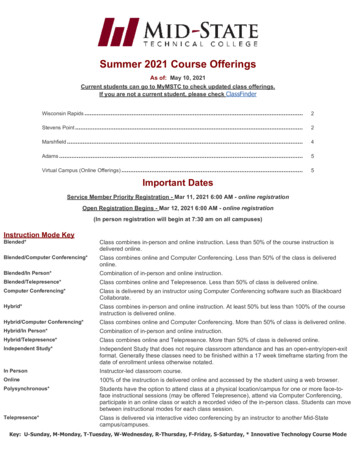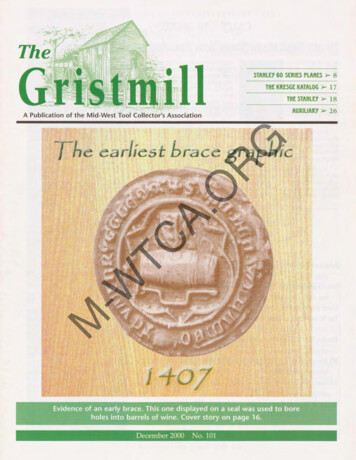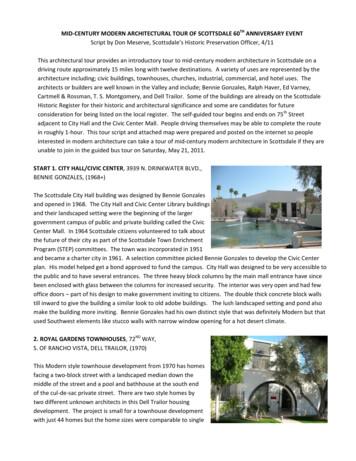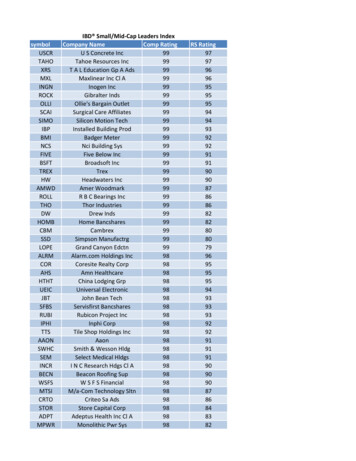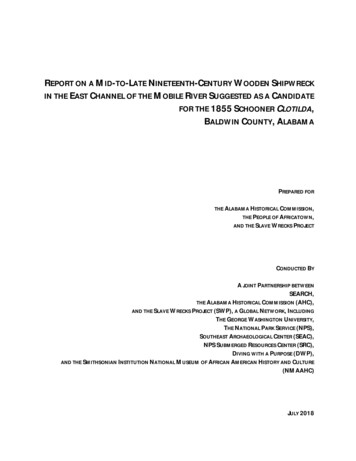
Transcription
REPORT ON A MID-TO-LATE NINETEENTH-CENTURY WOODEN SHIPWRECKIN THE EAST CHANNEL OF THE MOBILE RIVER SUGGESTED AS A CANDIDATEFOR THE 1855 SCHOONER CLOTILDA,BALDWIN COUNTY, ALABAMAPREPARED FORTHE ALABAMA HISTORICAL COMMISSION,THE PEOPLE OF AFRICATOWN,AND THE SLAVE WRECKS PROJECTCONDUCTED BYA JOINT PARTNERSHIP BETWEENSEARCH,THE ALABAMA HISTORICAL COMMISSION (AHC),AND THE SLAVE WRECKS PROJECT (SWP), A GLOBAL NETWORK, INCLUDINGTHE GEORGE WASHINGTON UNIVERSITY,THE NATIONAL PARK SERVICE (NPS),SOUTHEAST ARCHAEOLOGICAL CENTER (SEAC),NPS SUBMERGED RESOURCES CENTER (SRC),DIVING WITH A PURPOSE (DWP),AND THE SMITHSONIAN INSTITUTION NATIONAL MUSEUM OF AFRICAN AMERICAN HISTORY AND CULTURE(NMAAHC)JULY 2018
REPORT ON A MID-TO-LATE NINETEENTH-CENTURY WOODEN SHIPWRECKIN THE EAST CHANNEL OF THE MOBILE RIVER SUGGESTED AS A CANDIDATEFOR THE 1855 SCHOONER CLOTILDA, BALDWIN COUNTY, ALABAMAPREPARED BYJAMES P. DELGADO, PHD, RPA, KYLE LENT, MA, RPA, JOSEPH GRINNAN, MA, RPA,DAVID W. MORGAN, PHD, STACYE HATHORN, MA, AND DAVID CONLIN, PHDJULY 2018
Report on a Mid-to-Late Nineteenth-Century Wooden Shipwreck in the Mobile River, Baldwin County, AlabamaJuly 2018Final ReportEXECUTIVE SUMMARYThis report presents the results of a shallow-water archaeological investigation and diverevaluation of a potentially significant semi-submerged shipwreck site in the Mobile River nearTwelvemile Island, Baldwin County, Alabama. The resource is referred to as the TwelvemileIsland Wreck Site (1BA694), and has been registered by the Alabama Historical Commission(AHC) with the Director of the Office of Archaeological Research at the University of Alabama,as field site 1BA694. This report is prepared for AHC, the people of Africatown, and the SlaveWrecks Project (SWP), and was conducted by a joint partnership between SEARCH, AHC, andthe SWP, a global network including the George Washington University, the National ParkService (NPS) Southeast Archaeological Center (SEAC), and Submerged Resources Center (SRC)branches, Diving with a Purpose (DWP), and the Smithsonian Institution National Museum ofAfrican American History and Culture (NMAAHC). AHC contacted the partnership to assess thepreviously unrecorded resource in an effort to determine the identification of the wreck, andassess its eligibility for listing in the National Register of Historic Places (NRHP).The wreck of a mid- to late-nineteenth-century wooden vessel lies in the bank of the MobileRiver in the Mobile Bay Estuary off Twelvemile Island, Mobile, Alabama. On January 23, 2018,reporter Ben Raines of Al.com published a story that a partially buried wreck on the MobileRiver might be that of Clotilda, the last known ship to bring a human cargo bound for slavery tothe United States. The report noted that a preliminary assessment of the visible portions of thewreck by University of West Florida (UWF) archaeologists John Bratten and Greg Cook, andshipwright Winthrop Turner, indicated the wreck was that of a nineteenth-century craft, andthat there were visible indications of having been burned, features Raines noted wereconsistent with his theory that the wreck might be Clotilda. The story also noted that Brattenand Cook had stressed there was no conclusive documentation of the identity of the wreck andthat further research and excavation was needed (Raines 2018).The team conducted initial archival research to determine if the wreck had previously beendocumented in the archaeological record. The partnership also recommended a phasedapproach to archaeological examination of the wreck. The first phase would be preparation ofa detailed site map to document as much of the full extent of the wreck as possible. The initialphase would also include limited test excavation to assess hull form, determine the presence orlack of copper sheathing, and provide insight into the extent of burning on the vessel. Thefieldwork for this investigation was scheduled for, and took place on, March 1 to March 4, 2018,under the direction of Stacye Hathorn, MA, AHC State Archaeologist.Additionally, the team investigated five targets within close proximity to the Twelvemile IslandWreck (1BA694) location. The evidence of additional wreck sites suggested that the TwelvemileIsland Wreck (1BA694), and the area around the Twelvemile Island Wreck (1BA694), may bepart of a larger maritime landscape referred to colloquially as a “ship graveyard,” a locationwhere the hulls of scrapped vessels are left to decay. The five additional target areas wereinvestigated, four of which proved to be either ship remains or barge wrecks. The fifth (Target2) proved to be a natural feature. The four targets have been assigned provisional names: HicksiiiExecutive Summary
July 2018Final ReportReport on a Mid-to-Late Nineteenth-Century Wooden Shipwreck in the Mobile River, Baldwin County, Alabama(Target 1), Dobbs (Target 3), Harm (Target 4), and Kennedy (Target 5). Archaeological sitenumbers for these four targets have been assigned as follows: Hicks Wreck (1BA695), DobbsWreck (1BA696), Harms Wreck (1BA697), and Kennedy Wreck (1BA698).The team utilized high precision GPS, a Trimble Model M3 DR 5” total station, hand probing,photo documentation, measured drawings, artifact illustration, and field observations toconduct shallow-water archaeological investigation (i.e., archaeological investigation did notrequire diving technologies). In addition, the team conducted scientific diving utilizing SelfContained Underwater Breathing Apparatus (SCUBA) at the Twelvemile Island Wreck site. Diverinvestigations included those areas thought to include portions of shipwreck features, whichwere too deep for shallow water investigation. The team conducted a total of two dives fromMarch 1 to 2, 2018.The results of the investigation indicate that the Twelvemile Island Wreck is not that of theClotilda. Based on comparing the Twelvemile Island Wreck with Clotilda’s Certificate ofEnrolment and Registry, the overall length of the Twelvemile Island Wreck (1BA694) is muchlarger than that of Clotilda, the size of the timbers on the Twelvemile Island Wreck (1BA694)are much larger than that of the timbers on Clotilda, and the Twelvemile Island Wreck (1BA694)likely had three masts instead of Clotilda’s two. The Twelvemile Island Wreck (1BA694) alsowas constructed with flat iron reinforcement within the hull, which is commonly found onlarger wooden vessels than that of Clotilda. Additionally, no evidence of burning was observedon the Twelvemile Island Wreck (1BA694). Nine wood samples were collected during theMarch 2018 investigation and initial analysis suggests the samples consist of a combination ofDouglas Fir and Larch, a lumber typically grown and harvested in the Pacific Northwest regionof the United States.Although the team believes the Twelvemile Island Wreck is not the Clotilda, the grouping of fiveshipwrecks in close proximity, including Site 1BA694, represents a larger maritime landscape ofthe Mobile River, and is likely eligible for nomination to the NRHP under Criteria A, C, and Dpending further investigation. The Twelvemile Island Wreck vessel represents a uniqueexample of a likely mid-to-late nineteenth-century wooden, West Coast-built sailing vessel,probably a schooner, and may yield, or is likely to yield, information important to Mobile andthe broader history of the Gulf coast.The waterway along the Mobile River is an important and tangible element of maritimecommerce and maritime trade within the Delta, the Mobile River, and the city of Mobile,Alabama. The Twelvemile Island Wreck site appears to exist within, and is part of, a largermaritime landscape referred to as a ship graveyard. The overall boundaries of the waterway,including the Twelvemile River Wreck, the four additional wreck sites, and any additionalunrecorded resources that comprise the ship graveyard in the portion of the Mobile Riversurrounding the Twelvemile Island Wreck, are of national significance due to Mobile’simportant role in the history of the Gulf region and the nation and the Mobile waterfront, andmerit a comprehensive evaluation and a nomination to the NRHP. Such a nomination, withboundaries extending into the Mobile River to incorporate known and suspected submergedand buried features and artifacts, is key not only for recognizing the area’s significance, but alsoExecutive Summaryiv
Report on a Mid-to-Late Nineteenth-Century Wooden Shipwreck in the Mobile River, Baldwin County, AlabamaJuly 2018Final Reportfor asserting that what lies in the Mobile River is important and should be seen asarchaeological resources that will add to a more detailed understanding of the activities andpeople who worked there.vExecutive Summary
July 2018Final ReportReport on a Mid-to-Late Nineteenth-Century Wooden Shipwreck in the Mobile River, Baldwin County, AlabamaThis page intentionally left blank.Executive Summaryvi
Report on a Mid-to-Late Nineteenth-Century Wooden Shipwreck in the Mobile River, Baldwin County, AlabamaJuly 2018Final ReportACKNOWLEDGEMENTSSeveral individuals and organizations greatly contributed to the successful completion of thisproject. Most notably, the community members of Africatown, for whom we would like toextend our utmost gratitude to as they have allowed us all to play a small role in aiding in thenarrative of the people of Mobile River and the State of Alabama. We would like to thankSmithsonian Institution and the Slave Wrecks Project of the Smithsonian’s National Museum ofAfrican American History and Culture (NMAAHC), George Washington University, and theNational Park Service (NPS) for their support of this project, and in particular, we thank PaulGardullo, Steve Lubkemann, Mary Elliott, and Kamau Sadiki, for their ongoing support andassistance throughout the operation. We would also like to extend our recognition andgratitude to the staff at the Alabama Historical Commission (AHC), specifically Lisa D. Jones(Director), Stacye Hathorn (State Archaeologist), Clara Nobles (Assistant Executive Director), LeeAnne Wofford (Deputy State Historic Preservation Officer, Historic Preservation DivisionDirector), and Jacqulyn Kirkland, Eleanor Cunningham, and Dorothy Walker, whose tirelesscontributions allowed for the project to run smoothly throughout the entirety of the operation.We are grateful for Senator Vivian Figures for her involvement with this operation; herdedication to the project is a testament to her character as a person, and to how much shecares about the people of the State of Alabama.In February 2018, the Archaeological framework for the operation was established by anexecutive team including Lisa D. Jones, Dr. Paul Gardullo, and Dr. David Morgan. Fieldworkcrew consisted of Archaeologists Dr. James Delgado, Kyle Lent, and Joe Grinnan of SEARCH;Dr. David W. Morgan and Clete Rooney of NPS Southeast Archaeological Center (SEAC);Dr. Dave Conlin of NPS Submerged Resources Center (SRC); Stacye Hathorn of AHC; NMAAHCrepresentatives, including Mary Elliott and Kamau Sadiki; as well as the rest of theabovementioned AHC team. Stacye Hathorn was the project Principal Investigator, withDr. Conlin and Dr. Delgado as co- Principal Investigators. Mr. Grinnan served as dive safetyofficer and led dive operations. Mr. Lent served as archaeologist and diver, and was SEARCH’slead contributor for reporting of the investigation. David W. Morgan and Clete Rooney of NPSoffered their expertise and conducted GIS and total station recordation of the site, with DaveConlin and David W. Morgan acting as NPS liaisons and team archaeologists. As representativesof the NPS, the direction of leadership of Dr. Morgan and Dr. Conlin were instrumental in thesuccess of the project.We are indebted to The City of Mobile and the University of Southern Alabama, who wentabove and beyond the call of duty by providing operational support during the project, alongwith Alabama Department of Conservation and Natural Resources officers Jeremy Hicks, JordanKennedy, Thomas Harms, and Joseph Dobbs Jr., who piloted and transported team memberswhile on the water in Mobile.We would also like to extend our gratitude to Alabama news reporter Mr. Ben Raines, whoseinitial groundwork investigations led to this operation, as well as University of West FloridaviiAcknowledgements
July 2018Final ReportReport on a Mid-to-Late Nineteenth-Century Wooden Shipwreck in the Mobile River, Baldwin County, Alabamaarchaeologists Dr. John Bratten and Dr. Greg Cook, and shipwright Winthrop Turner, whoindicated that the wreck site may be of a nineteenth-century watercraft. We also thankDr. Amy Mitchell-Cook, who provided laboratory analysis and identification of wood samplestaken from the wreck site.This report is the result of the combined efforts of multiple specialists who completedbackground research, analysis, and authorship in their various specializations. Special credit isgiven to John Cloud and Dr. Delgado of SEARCH for providing archaeological and historicalcharacterization, and Mr. Lent for compiling the report. In-house SEARCH support included RayTubby, MA, and Christopher Altes, MA (GIS), and Katy Harris, MS (Lead Technical Editor).Our knowledge of current maritime landscapes and the historic context of the Mobile River wasenhanced by time shared with John Sledge, Historian. Finally, we would like to thank the AHCfor their continued efforts in overseeing the preservation of Mobile River’s rich culturalheritage.Acknowledgementsviii
Report on a Mid-to-Late Nineteenth-Century Wooden Shipwreck in the Mobile River, Baldwin County, AlabamaJuly 2018Final ReportTABLE OF CONTENTSExecutive Summary.iiiAcknowledgements. viiTable of Contents . ixList of Figures . xiList of Tables . xvIntroduction . 1Project Background . 1Environmental Conditions . 4Project Personnel . 4Survey Expectations . 5Historic Background . 6Africatown and Clotilda . 7The Development of the American Schooner . 7Characteristics of Clotilda . 10Presumed Site Formation Processes for Clotilda. 12Twelvemile Island . 14Historic Photograph and Map Review of the Project Area . 14Navigation Charts and Aerials . 15Methods . 23Dive Operations . 24Survey/Dive Vessel. 24Survey Equipment and Site Relocation . 25Results . 26Twelvemile Island Wreck (1BA694) . 27Ship Components . 30Analysis . 41Additional Fieldwork Photos and Total Station Results. 45Probable Context . 54Additional Shipwrecks Investigated . 55Target 1: Hicks Wreck (1BA695) . 55Target 2: Trees . 58Target 3: Dobbs Wreck (1BA696). 58Target 4: Harms Wreck (1BA697) . 59Target 5: Kennedy Wreck (1BA698). 61NRHP Evaluation . 64The Development of the American Barge . 65Understanding and Assessing a Ship Graveyard. 67NRHP Eligibility . 69Conclusions and Recommendations . 73References Cited . 74Appendix A:Dive LogsixTable of Contents
July 2018Final ReportReport on a Mid-to-Late Nineteenth-Century Wooden Shipwreck in the Mobile River, Baldwin County, AlabamaThis page intentionally left blank.Table of Contentsx
Report on a Mid-to-Late Nineteenth-Century Wooden Shipwreck in the Mobile River, Baldwin County, AlabamaJuly 2018Final ReportLIST OF FIGURESFigure 1. Aerial of the Twelvemile Island Wreck (1BA694) location in the Mobile River,Baldwin County, Alabama. . 2Figure 2. Topographic Map of the Twelvemile Island Wreck (1BA694) in the Mobile River,Baldwin County, Alabama. . 3Figure 3. Environmental conditions were favorable during fieldwork with clear days, cooltemperatures, and 65 F water temperature. View southwest down MobileRiver. . 4Figure 4. Clotilda’s Certificate of Enrolment and Regist
report on a mid-to-late nineteenth-century wooden shipwreck in the east channel of the mobile river suggested as a candidate for the 1855 schooner clotilda. b. aldwin. c. ounty, a. labama. prepared for. the alabama historical commission,. the people of africatown,. and the slave wrecks project. conducted . by. a joint partnership b
